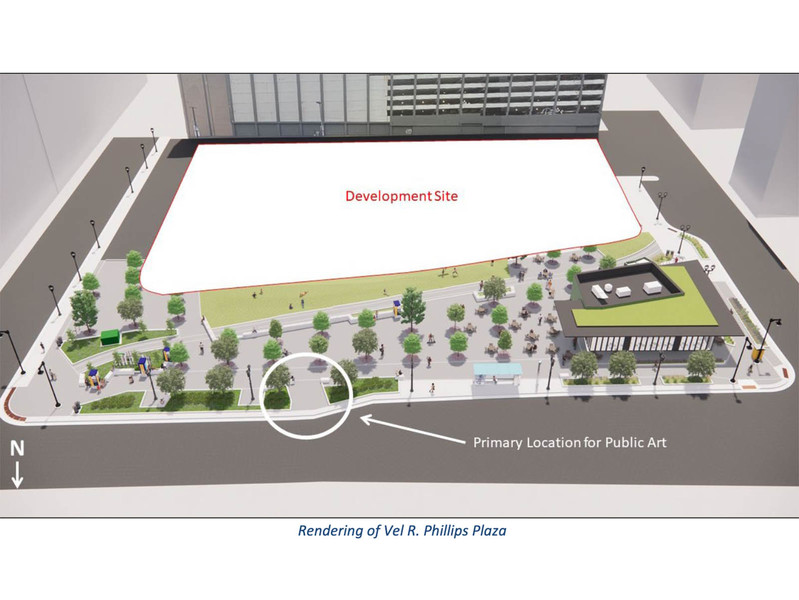Reginald Baylor has a problem with reading.
"I do not see pictures when I read words," the Milwaukee-based artist said. "I can’t get the environment processed in my mind. Those letters don’t translate into an environment."
Interestingly enough, that’s exactly what Baylor’s latest art project aims to do: translate and transform words into something that visually reflects an environment, or, in the case of this project, a community.
It’s called TypeFace, a collection of four public art installations scattered across four Milwaukee neighborhoods. Each one takes a once-blank area where something was closed and left vacant, and turns it into a canvas.
There’s "An Arrangement," an artistic bouquet located on the 31st Street Mini-Mart on the corner of 31st and Burnham; "Bookshed," a free library going into Lindsay Heights; "Panel Discussion," a mural set to go over the green boards covering the windows at the closed Finney Library, 4243 W. North Ave.; and "Puzzled & Amazed," a collection of benches located in the Harambee neighborhood in the former site of the Main Event.
Each work of art – some of which are already up now, and some of which will be up shortly in the upcoming weeks – is comprised of the words of their respective communities, organized into new eye-catching forms and shapes.
The original concept hit Baylor back in late 2011 while talking with Angelique Power of the Joyce Foundation over Skype about the Joyce Grant – a $50,000 art grant – its requirements and potential project ideas.
"Everything made sense to me not trying to interpret the communities artistically, but to simply ask the community," Baylor said. "Then I said, ‘Why don’t I do it with words?’ As soon as I said that, I thought of Adam."
Adam Carr first met Baylor back when Carr was working at 88Nine Radio Milwaukee. It didn’t take long for the two to become friends, discovering they had a lot in common. They both like "The Larry Sanders Show," and they have the same favorite book, "Slapstick" by Kurt Vonnegut.
"We realized we could talk at each other exactly how we are," Baylor said.
"It’s just like listening to yourself, which is sometimes really awesome and sometimes it’s like, ‘Shut up, other self,’" Carr joked. "So when Reggie came to me about the project, it was an immediate yes."
The two, alongside Art Milwaukee, joined together, evolving TypeFace into the public art project it is today. They received the grant from the Joyce Foundation near the end of 2012, as well as the ensuing immediate stress and pressure of such responsibility. They then selected the four sites and four communities that would be the focus of the installations.
Then, this summer, Carr went out into four separate neighborhoods, asking specific community-tailored questions – both broad and particular – to the residents in the hopes of finding out and revealing their history and identity.
"How can you get from community members authentic and transparent self-expression?" Carr said. "Like truly of the self, not ‘What do you want from me? Let me try to deliver that,’ because that’s how a lot of people respond to an interview. The real challenge is how do you get someone into a space of intimacy and not even necessarily trust because some of the best stuff came from people who were distrusting in some ways but authentically responding to the prompts and themselves."
In the case of Harambee, Carr’s questions focused in on the Main Event, a community intersection that was demolished back in 2011. For Lindsay Heights, he asked the question, "Who are you, and when do you feel most connected to that person?" For the corner mini-mart in Burnham Park, the question was small yet massive: "Why here?"
"I was so glad I talked to Adam right away because if I went into the community, it’d be, ‘Hey … what’s up?’" Baylor said. "I would go from there and not know what to do."
"In conducting these conversations, it was important to me that the questions were so basic that it allowed people to be who they were," Carr said. "There was humor, a lot of laughter, a lot of pain, a lot of wisdom and a lot of regular stuff too. That’s what communities are, and that’s what people are. Those conversations got really real, and I forgot that I was doing interviews. And that’s when I knew it was working."
Carr then passed the conversations and statements onto Baylor, who transformed the words, or "wisdom," as he often called them, into works of art that were both aesthetically intriguing while staying true to the community’s thoughts and avoiding interpretation.
"I just want to represent them in a way that compels a person to actually want to read them," Baylor said. "I mean, we could’ve rolled them on an 8½ by 11 piece of paper and stacked them on, and people would be like, ‘Okay.’ I looked at it as an opportunity to have a really high aesthetic visual in the community to draw attention to what the community has to say about itself."
One of the big ways in which Baylor tried to do this is through visual puzzles and games. In the case of the Finney Library panel murals, the community’s answers are put into a visual wordplay game.
"Even though I knew we wanted people to read them, I was going to try to abstract the composition because that, to me, adds a level of interest," Baylor said. "In a matter of fact, one of the things Adam told me in the beginning was this idea of neo-graffiti. When he said that, I thought I know what he’s talking about. It’s just like boom. Keith Haring and Basquiat are probably two of my top favorite artists, and they’re graffiti artists. Here was an opportunity to do some new graffiti."
The Harambee work – which Baylor noted was the most difficult and mind-occupying of all four pieces – was originally visualized as a performance stage before it became a collection of benches, organized not only as a puzzle but also a maze. Baylor himself isn’t quite sure if it’s solvable.
"I started with the maze and deconstructed it, thinking that it could be constructed by how meticulous I was in the deconstruction," Baylor said. "We plan to create a PDF file of the maze to see if it can be constructed. I’d be interested to see if it is solvable."
For any adventure-seeking puzzle lovers, the artist did provide one tiny clue.
"It is two components: a puzzle and a maze," Baylor hinted. "The puzzle actually has nothing to do with the content in the maze. Putting the pieces together is not connecting the words; it’s just connecting the shapes."
Both Baylor and Carr know that TypeFace could never completely capture every facet of these complex, complicated and always changing communities. But they did strive to get as much meaning and involvement as possible into the works.
"If you drive by Finney Library today, and you don’t know the history, you don’t get anything from that experience," Carr said. "We’re bringing some of that experience and the fabric of the community back to those spaces a bit."
As much as it is a gigantic cliché to say that one has always had a passion for film, Matt Mueller has always had a passion for film. Whether it was bringing in the latest movie reviews for his first grade show-and-tell or writing film reviews for the St. Norbert College Times as a high school student, Matt is way too obsessed with movies for his own good.
When he's not writing about the latest blockbuster or talking much too glowingly about "Piranha 3D," Matt can probably be found watching literally any sport (minus cricket) or working at - get this - a local movie theater. Or watching a movie. Yeah, he's probably watching a movie.







